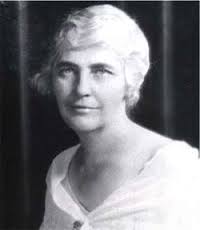|
Lou Hoover
During World War I, she assisted her husband in providing relief for Belgian refugees. For her work she was decorated in 1919 by King Albert I of Belgium. During this time Herbert served as head of the U.S. Food Administration and she became a leader in the Girl Scouts and the National Amateur Athletic Federation. Lou worked to enlist women in America into the food conservation program. Wheatless and meatless days were arranged, and "Food Will Win the War," became the national slogan. After Herbert Hoover became the president, she decided to restore the Lincoln Study to an office from its present status as a bedroom. She refurbished and restored the study with as much original furniture as she could locate. Many of the White House restoration projects were done at her own expense. She did her best to make the White House more comfortable. Not only did she buy more comfortable furniture, but she also made her guests feel at home too. Lou Hoover had a knack for mixing all sorts of people and making each feel important. She eliminated barriers between special and ordinary guests. A Girl Scout would receive as much attention from Mrs. Hoover as would an ambassador. She was the first to fully catalog the contents of the White House. Throughout her life, Lou Hoover always enjoyed getting away, and doing something outdoors. The White House years proved to be no exception. Lou Hoover located and oversaw the building of a retreat in the Blue Ridge Mountains for President Hoover. Camp Rapidan in Madison County, Virginia became a place for informal entertaining and relaxing. The camp consisted of a series of cabins and walking paths by the headwaters of the Rapidan River. Once when Lou was recovering from a back injury by relaxing at Camp Rapidan, she discovered that there was no school in the mountains for the children who lived there. She and Herbert decided to build The President's Community School and to hire a teacher for the school. This was done at the Hoover's own expense. They also built a small apartment for the teacher's use. Upon leaving office, the Hoovers donated Camp Rapidan to the government. The Hoovers left Washington, D.C. in 1933. Lou was looking forward to time in California. After several years the Hoovers moved to the Towers at the Waldorf Astoria Hotel in New York City, so that Herbert Hoover could work on relief efforts once again. This time it was the Finnish Relief Fund which was necessary because of the outbreak of World War II. As usual, Lou Hoover assisted with the relief work. She was also elected chairman of the Western Women's Committee which assisted the Salvation Army in its campaign to gather clothing for the millions of war refugees in Europe. After attending a concert with friends on January 7, 1944, Lou Hoover retired to her bedroom for a brief nap. She was struck by an acute heart attack from which she didn't recover. Lou Hoover was 69 years old when she died. She was buried in Alta Mesa Cemetery, Palo Alto, California. She was re-interred in 1964 at Herbert Hoover Presidential Library in West Branch, Iowa. |
 Lou
Hoover met future president Herbert Hoover while they attended Stanford
University. She became a cultivated scholar and linguist. A proficient
Chinese speaker, she is the only First Lady to have spoken an Asian
language. She was the first First Lady to make regular nationwide radio
broadcasts.
Lou
Hoover met future president Herbert Hoover while they attended Stanford
University. She became a cultivated scholar and linguist. A proficient
Chinese speaker, she is the only First Lady to have spoken an Asian
language. She was the first First Lady to make regular nationwide radio
broadcasts.